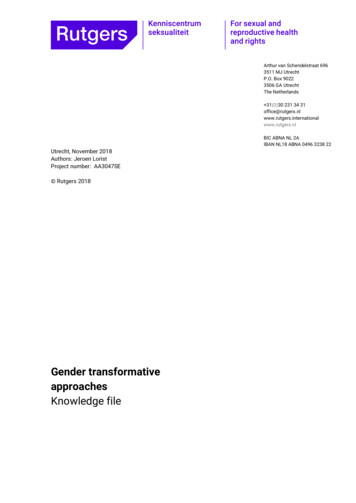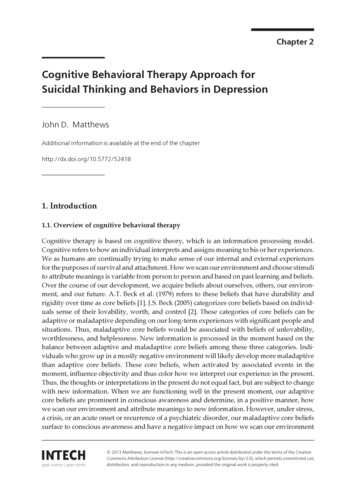
Transcription
SOCIAL COGNITIVE THEORY OF GENDER DEVELOPMENT ANDDIFFERENTIATIONKay BusseyAlbert BanduraMacquarie UniversityStanford UniversityAbstractHuman differentiation on the basis of gender is a fundamental phenomenon that affectsvirtually every aspect of people’s daily lives. This article presents the social cognitive theory ofgender-role development and functioning. It specifies how gender conceptions are constructedfrom the complex mix of experiences and how they operate in concert with motivational andself-regulatory mechanisms to guide gender-linked conduct throughout the life course. Thetheory integrates psychological and sociostructural determinants within a unified conceptualstructure. In this theoretical perspective, gender conceptions and roles are the product of a broadnetwork of social influences operating interdependently in a variety of societal subsystems.Human evolution provides bodily structures and biological potentialities that permit a range ofpossibilities rather than dictate a fixed type of gender differentiation. People contribute to theirself-development and bring about social changes that define and structure gender relationshipsthrough their agentic actions within the interrelated systems of influence.Bussey, K., & Bandura, A. (1999). Social cognitive theory of gender development anddifferentiation. Psychological Review, 106, 676-713.1
SOCIAL COGNITIVE THEORY OF GENDER DEVELOPMENTThe present article addresses the psychosocial determinants and mechanisms by which societysocializes male and female infants into masculine and feminine adults. Gender development is afundamental issue because some of the most important aspects of people’s lives, such as the talents theycultivate, the conceptions they hold of themselves and others, the sociostructural opportunities andconstraints they encounter, and the social life and occupational paths they pursue are heavily prescribedby societal gender-typing. It is the primary basis on which people get differentiated with pervasive effectson their daily lives. Gender differentiation takes on added importance because many of the attributes androles selectively promoted in males and females tend to be differentially valued with those ascribed tomales generally being regarded as more desirable, effectual and of higher status (Berscheid, 1993).Although some gender differences are biologically founded, most of the stereotypic attributes and roleslinked to gender arise more from cultural design than from biological endowment (Bandura, 1986; Beall& Sternberg, 1993; Epstein, 1997). This article provides an analysis of gender role development andfunctioning within the framework of social cognitive theory and distinguishes it from other theoreticalformulations.Theoretical PerspectivesOver the years several major theories have been proposed to explain gender development. Thetheories differ on several important dimensions. One dimension concerns the relative emphasis placed onpsychological, biological, and sociostructural determinants. Psychologically-oriented theories tend toemphasize intrapsychic processes governing gender development (Freud, 1905/1930; Kohlberg, 1966). Incontrast, sociological theories focus on sociostructural determinants of gender-role development andfunctioning (Berger, Rosenholtz, & Zelditch, 1980; Eagly, 1987a; Epstein, 1988). According tobiologically-oriented theories, gender differences arising from the differential biological roles played bymales and females in reproduction underlie gender-role development and differentiation (Buss, 1985;Trivers, 1972).A second dimension concerns the nature of the transmission models. Psychological theoriestypically emphasize the cognitive construction of gender conceptions and styles of behavior within thefamilial transmission model. This model was accorded special prominence mainly as a legacy of Freud'semphasis on adoption of gender roles within the family through the process of identification.Behavioristic theories also have accorded prominence to parents in shaping and regulating gender-linkedconduct. In theories favoring biological determinants, familial genes are posited as the transmission agentof gender differentiation across generations (Rowe, 1994). Sociologically-oriented theories emphasize thesocial construction of gender roles mainly at the institutional level (Lorber, 1994). Social cognitive theoryof gender-role development and functioning integrates psychological and sociostructural determinantswithin a unified conceptual framework (Bandura, 1986; 1997). In this perspective, gender conceptionsand role behavior are the products of a broad network of social influences operating both familially and inthe many societal systems encountered in everyday life. Thus, it favors a multifaceted social transmissionmodel rather than mainly a familial transmission model.The third dimension concerns the temporal scope of the theoretical analyses. Most psychologicaltheories treat gender development as primarily a phenomenon of early childhood rather than one thatoperates throughout the life course. However, rules of gender-role conduct vary to some degree acrosssocial contexts and at different periods in life. Moreover, sociocultural and technological changesnecessitate revision of pre-existing conceptions of what constitutes appropriate gender conduct. Genderrole development and functioning are not confined to childhood but are negotiated throughout the lifecourse. While most theories of gender development have been concerned with the early years ofdevelopment (Freud, 1916/1963; Kohlberg, 1966) or have focused on adults (Deaux & Major, 1987),sociocognitive theory takes a life-course perspective. Therefore, in the following sections, the analysis ofthe sociocognitive determinants of gender orientations will span the entire age range. Nor is the theoryrestricted predominantly to cognitive or social factors. Rather cognitive, social, affective and motivationalprocesses are all accorded prominence. Before presenting the sociocognitive perspective on gender2
development, the main psychological, biological and sociological perspectives on gender differentiationare briefly reviewed.Psychoanalytic Theory.Psychoanalytic theory posited different processes to explain gender development in boys andgirls. Initially, both boys and girls are believed to identify with their mothers. However, between 3 to 5years of age this changes and children identify with the same-sex parent. Identification with the same-sexparent is presumed to resolve the conflict children experience as a result of erotic attachment to theopposite-sex parent and jealousy toward the same-sex parent. This attachment causes children muchanxiety as they fear retaliation from the same-sex parent. The lack of a visible genitalia in girls fuels boys'castration anxieties. Girls face a more complex situation. They feel resentment over being deprived of apenis, inferior, and fear retaliation from the mother for their designs on their father. The conflictingrelationship is resolved through identification with the same-sex parent.The process of identification is depicted as one in which children undertake wholesale adoptionof the characteristics and qualities of the same-sex parent. Through this process of identification, childrenbecome sex-typed. Because identification with the same-sex parent is stronger for boys than girls, boysare expected to be more strongly sex-typed.Although psychoanalytic theory has had a pervasive early influence in developmentalpsychology, there is little empirical evidence to support it. A clear relationship between identificationwith the same-sex parent and gender-role adoption has never been empirically verified (Hetherington,1967; Kagan, 1964; Payne and Mussen, 1956). Children are more likely to model their behavior afternurturant models or socially powerful ones than after threatening models with whom they have a rivalrousrelationship (Bandura, Ross, & Ross, 1963b).Lack of empirical support for classic psychoanalytic theory has led to a variety of reformulationsof it. In the gender domain, a notable recasting is offered by Chodorow (1978). In this view, genderidentification begins in infancy rather than during the later phallic stage as proposed by Freud. Both maleand female infants initially identify with their mother. However, because the mother is of the same sex asher daughter, identification is expected to be stronger between mothers and their daughters than betweenmothers and their sons. During the course of development, girls continue to identify with their mothersand they also psychologically merge with her. As a consequence, the daughter’s self-concept ischaracterized by mutuality and a sense of relatedness that orients her towards interpersonal relationships.This interpersonal orientation is the main reason why women engage in mothering. They seek to reestablish a sense of interpersonal connectedness reminiscent of their relationship with their mother butabsent in their adult relationships with men. This pattern of development contrasts with that of boys whoincreasingly separate themselves from their mothers and define themselves in terms of difference fromfemales. They begin to denigrate femininity in an attempt to establish their own separateness andindividuation.The empirical findings, however, are no more supportive of Chodorow’s theory than of classicpsychoanalytic theory. There is no evidence that the attachment bond is any stronger between mothersand daughters than mothers and sons (Sroufe, 1985). Nor is there any evidence that women’s relationalneeds and sense of well-being are fulfilled only by being mothers. Bernard (1972) notes that womenwhose sole role is one of mother and wife have higher rates of mental dysfunction than childless marriedand single women and working mothers. Finally, this theory is at odds with women’s striving for greaterindependence and equality between the sexes (Sayers, 1986).Cognitive Developmental Theory.According to cognitive developmental theory, gender identity is postulated as the basic organizerand regulator of children's gender learning (Kohlberg, 1966). Children develop the stereotypicconceptions of gender from what they see and hear around them. Once they achieve gender constancy -the belief that their own gender is fixed and irreversible -- they positively value their gender identity and3
seek to behave only in ways that are congruent with that conception. Cognitive consistency is gratifying,so individuals attempt to behave in ways that are consistent with their self-conception. Kohlberg positedthe following cognitive processes that create and maintain such consistency: "I am a boy, therefore I wantto do boy things, therefore the opportunity to do boy things (and to gain approval for doing them) isrewarding" (Kohlberg, 1966, p. 89). In this view, much of children's conduct is designed to confirm theirgender identity. Once children establish knowledge of their own gender, the reciprocal interplay betweenone's behavior (acting like a girl) and thoughts (I am a girl) leads to a stable gender identity, or incognitive-developmental theory terms, the child achieves gender constancy.Kohlberg defined gender constancy as the realization that one’s sex is a permanent attribute tiedto underlying biological properties and does not depend on superficial characteristics such as hair length,style of clothing, or choice of play activities (Kohlberg, 1966). Development of gender constancy is notan all or none phenomenon. Three discrete levels of gender understanding comprise gender constancy(Slaby & Frey, 1975). From least to most mature forms of gender understanding, these are designated asthe gender identity, stability, and consistency components of gender constancy. "Gender identity" requiresthe simple ability to label oneself as a boy or girl and others as a boy, girl, man, or woman. "Genderstability" is the recognition that gender remains constant over time -- that is, one's sex is the same now asit was when one was a baby and will remain the same in adulthood. The final component of genderconstancy, "gender consistency", is mastered at about age six or seven years. The child now possesses theadded knowledge that gender is invariant despite changes in appearance, dress or activity. Children arenot expected to adopt gender-typed behaviors consistently until after they regard themselves unalterablyas a boy or a girl, which usually is not achieved until about six years of age.Although Kohlberg's theory attracted much attention over the decades, its main tenets have notfared well empirically. Studies generally have failed to corroborate the link between children's attainmentof gender constancy and their gender-linked conduct (Huston, 1983). Long before children have attainedgender constancy, they prefer to play with toys traditionally associated with their gender (Carter & Levy,1988; Emmerich & Shepard, 1984; Levy & Carter, 1989; Lobel & Menashri, 1993; Marcus & Overton,1978; Martin & Little, 1990), to model their behavior after same-sex models (Bussey & Bandura, 1984),and to reward peers for gender- appropriate behavior (Bussey & Bandura, 1992; Lamb & Roopnarine,1979). Moreover, growing awareness of gender constancy does not increase children's preferences forsame-gender roles and activities (Marcus & Overton, 1978; Smetana & Letourneau, 1984).The findings of other lines of research similarly fail to support the major tenets of this theory.Although stable gender constancy is not attained until about six years of age, 2-year olds performremarkably well in sorting pictures of feminine and masculine toys, articles of clothing, tools andappliances in terms of their typical gender relatedness (Thompson, 1975). Children's ability to classifytheir own and others' sex and some knowledge of gender-role stereotypes is all that is necessary for muchearly gender typing to occur. These categorization skills are evident in most three- and four-year olds.Clearly, gender constancy is not a prerequisite for gender development. Factors other than genderconstancy govern children's gender-linked conduct.In response to the negative findings, the gender constancy measure was modified to demonstratethat the assessment procedure rather than the theory is at fault for the lack of linkage of gender constancyto gender conduct. The modifications included altering the inquiry format, the use of more realisticstimuli, and less reliance on verbal responses (Bem, 1989; Johnson & Ames, 1994; Martin & Halverson,1983; Siegal & Robinson, 1987). Although some of these modifications showed that children understandgender constancy earlier than Kohlberg had suggested, most children under 4 years do not fullyunderstand the concept of constancy regardless of the form of its assessment (Bem, 1989; Frey & Ruble,1992; Slaby & Frey, 1975). More importantly, there is no relationship between children's understandingof gender constancy and their preference for gender-linked activities, preference for same-gender peers,or emulation of same-gender models, regardless of how gender constancy is assessed (Bussey & Bandura,1984, 1992; Carter, 1987; Carter & Levy, 1988; Huston, 1983; Martin & Little, 1990).Gender Schema Theory.4
Several gender schema theories have been proposed to explain gender development anddifferentiation. The social psychological approaches advanced by Bem and Markus and her associateshave centered mainly on individual differences in gender schematic processing of information (Bem,1981; Markus, Crane, Bernstein, & Siladi, 1982). Martin and Halverson’s (1981) approach emphasizesthe developmental aspects of schema development and functioning. This theory has many similarities tocognitive-developmental theory, but departs from it in several ways. Rather than requiring the attainmentof gender constancy for development of gender orientations, only the mastery of gender identity, theability of children to label themselves and others as males or females, is considered necessary for genderschema development to begin (Martin & Halverson, 1981). Once formed, it is posited that the schemaexpands to include knowledge of activities and interests, personality and social attributes, and scriptsabout gender-linked activities (Levy & Fivush, 1993; Martin, 1995; Martin & Halverson, 1981). Theschema is presumably formed from interactions with the environment, but the process by which genderfeatures that constitute the knowledge structure of the schema are abstracted remain unspecified.Once the schema is developed, children are expected to behave in ways consistent with traditionalgender roles. The motivating force guiding children's gender-linked conduct, as in cognitivedevelopmental theory, relies on gender-label matching in which children want to be like others of theirown sex. For example, dolls are labeled "'for girls' and 'I am a girl' which means 'dolls are for me'"(Martin & Halverson,1981, p.1120). However, in addition to the lack of specification of the genderabstraction process, empirical efforts to link gender schema to gender-linked conduct in young childrenhave not fared well.Results of empirical tests call into question the determinative role of gender schema. Theevidence linking gender labeling to activity and peer preferences is mixed at best. A few studies havefound a link (Fagot & Leinbach,1989), others report conflicting results across different measures ofgender-linked conduct (Martin & Little, 1990), and still others have failed to find any link at all (Fagot,1985; Fagot, Leinbach, & Hagen, 1986). Even in the studies that report a relationship, it remains to bedetermined whether gender labeling and gender-linked preferences are causally linked or are merelycoeffects of social influences and cognitive abilities. Parents who react evaluatively to gender-linkedconduct have children who are early gender labelers (Fagot & Leinbach, 1989). Hence, gender labelingand preference may both be products of parental influence.Knowledge of gender stereotypes, which are generalized preconceptions about the attributes ofmales and females, is similarly unrelated to gender-linked conduct (Huston, 1983; Martin, 1993;Signorella, 1987). Children's preferences for gendered activities emerge before they know the genderlinkage of such activities (Blakemore, Larue & Olejnik, 1979; Martin, 1993; Perry, White, & Perry, 1984;Weinraub et al., 1984). A gender schema represents a more generic knowledge structure about malenessand femaleness. Gender schema theory would predict that the more elaborated the gender knowledgechildren possess, the more strongly they should show gender-linked preferences. However, thishypothesized relationship receives no empirical support (Martin, 1991). Adults, for example, may be fullyaware of gender stereotypes but this does not produce incremental prediction of gender-linked conduct assuch knowledge increases. These various results fail to confirm gender knowledge as the determinant ofgender-linked conduct.Gender schema theory has provided a useful framework for examining the cognitive processingof gender information once gender schemas are developed. In particular, it has shed light on how genderschematic processing affects attention, organization, and memory of gender-related information (Carter &Levy, 1988; Ruble & Martin, 1998). Other models of gender schema that focus on adults have similarlydemonstrated gender biases in information processing (Bem, 1981; Markus, Crane, Bernstein, & Siladi,1982). The more salient or available the schema, the more individuals are expected to attend to, encode,represent, and retrieve information relevant to gender. However, gender-schematic processing is unrelatedto either children's or adult’s gender conduct or the findings are inconsistent across different measures ofgender schematization (Bem, 1981; Carter & Levy, 1988; Edwards & Spence, 1987; Signorella, 1987).A gender schema is not a monolithic entity. Children do not categorize themselves as "I am girl"or "I am a boy" and act in accordance with that schema invariantly across situations and activity domains.Rather they vary in their gender conduct depending on a variety of circumstances. Variability is present at5
the adult level as well. A woman may be a hard-driving manager in the workplace but a traditionalist inthe functions performed in the home. Some students of gender differentiation, drawing on Lifton's (1994)"protean self", explain contradictory gender-role behavior in terms of subselves doing their separatethings (Epstein, 1997). The problems with a multiple-self theory have been addressed elsewhere and willbe mentioned only briefly here (Bandura, 1997, 1999). It requires a regress to a superordinate self whohas to manage the inharmonious subselves. There is really only one self that can do diverse things,including discordant ones on different occasions and under different circumstances. The selectiveengagement and disengagement of self-regulatory mechanisms by the same being predict variation inconduct, including contradictory styles of behavior (Bandura, 1986; 1991a)A further limitation of gender schema theory is that it cannot explain the asymmetry in findingsbetween boys and girls. Boys and girls differ in the extent to which they prefer same-gender activities,emulate same-gender models and play with same-gender peers, yet most studies find no differences ingirls' and boys' gender stereotypic knowledge (Reis & Wright, 1982; Serbin, Powlishta & Gulko, 1993).Both cognitive-developmental theory and gender schema theory have focused on genderconceptions, but neither devotes much attention to the mechanisms by which gender-linked conceptionsare acquired and translated to gender-linked conduct. Nor do they specify the motivational mechanism foracting in accordance with a conception. Knowing a stereotype does not necessarily mean that one strivesto behave in accordance with it (Bandura, 1986). For example, self-conception as an elderly person doesnot enhance valuation and eager adoption of the negative stereotypic behavior of old age. Evidence thatgender conception is insufficient to explain variations in gender-linked conduct should not bemisconstrued as negation of cognitive determinants. As will be explained in subsequent sections, socialcognitive theory posits a variety of motivational and self-regulatory mechanisms rooted in cognitiveactivity that regulate gender development and functioning. These include, among other things, cognitionsconcerning personal efficacy, evaluative standards, aspirations, outcome expectations rooted in a valuesystem, and perception of sociostructural opportunities and constraints.Biological TheoriesBiologically-oriented theories have also been proposed to explain gender development anddifferentiation. Evolutionary psychology is one such theory that views gender differentiation asancestrally programmed (Archer, 1996; Buss, 1995; Simpson & Kenwick, 1997). The ancestral origin ofdifferences in gender roles is analyzed in terms of mate preferences, reproductive strategies, parentalinvestment in offspring, and the aggressive nature of males. Viewed from this perspective, contemporarygender differences originated from successful ancestral adaptation to the different reproductive demandsfaced by men and women. Men contributed less to their offsprings’ chances of survival so they soughtmultiple partners and were less choosy with whom to mate. In addition, uncertainty of paternity raised therisk of investing resources in children who were not their own. In contrast, women have to carry the fetusand care for their offspring years after their birth. Women adapted to their greater imposed role inreproduction and parenting by preferring fewer sexual partners and favoring those who would be goodlong-term providers of the basic necessities of life for themselves and their offspring. Men, in contrast,attempted to maximize the likelihood of paternity by reproducing with numerous young and physicallyattractive females, suggestive of high fertility. Because of their size and strength advantage, malesresolved problems arising from conflicting reproductive interests by exercising aggressive dominanceover females. Coercive force enables males to control female’s sexuality and to mate with many females(Smuts, 1992, 1995). As a legacy of this evolutionary history, women have come to invest more heavilythan men in parenting roles (Trivers, 1972). Males, in turn, evolved into aggressors, social dominatorsand prolific maters because such behavior increased their success in propagating their genes. Accordingto evolutionary psychology, many current gender differences, such as the number of sexual partnerspreferred, criteria for selecting sexual partners, aggression, jealousy and the roles they fulfill originatedfrom the ancestral sex differentiated reproductive strategies (Buss, & Schmitt, 1993). For example, thefindings that men prefer women who are young and physically attractive and women prefer men who arefinancially well resourced as mates are considered supportive of biological selection.6
Not all evolutionary theorists speak with one voice, however. Psychological evolutionists oftentake a more extreme deterministic stance regarding the rule of nature (Buss, 1995; Archer, 1996) than domany biological evolutionists (Dobzhansky, 1972; Fausto-Sterling, 1992; Gould, 1987; Gowaty, 1997).Psychological evolutionists are also quick to invoke evolved behavioral traits as cultural universals,whereas biological evolutionists emphasize functional relations between organism and situatedenvironment that underscores the diversifying selection influence of variant ecological contexts(Caporael, 1997). It should also be noted that evolutionary psychology grounds gender differences inancestral mating strategies, but it does not address at all the developmental changes that occur in genderconceptions and gendered conduct. Nor does it specify the determinants and mechanisms governingdevelopmental changes across the life course.Natural selection shapes for proximate utility not future purpose (Gould, 1987). Bodily structuresand biological potentialities are shaped by the aimless forces of natural selection acting on randommutations or new gene recombinations. Depiction of ancestral males as seeking to maximize paternity andof ancestral females as looking for good providers suggest that they are acting on deliberate or tacitpurpose. Strategies subserve goals. Such appending of purpose to mating patterns and calling them“strategies,” which are designed to bring about some goal, sounds more like a teleological explanationthan a Darwinian functional explanation. Disclaimers that the strategies are not always in awareness stillleaves them undertaken for some particular end. Moreover, it is conceptually and methodologicallyproblematic to use mindful self-ratings as the indicants of mating preferences to which the individualssupposedly have no conscious access. The claim that evolutionary psychology provides the solution to theorigin of gender differences in social behavior simply raises the regress problem. For example,evolutionary explanations that attribute mating practices to “strategies” rather than to the work of blindselection forces beg the question of why males should seek to maximize paternity.Evolutionary psychology is proposed as a superior alternative to more socially orientedexplanations of gender differentiation (Archer, 1996). However, this view, which attributes overridingpower to biology, is not without serious problems. It is mainly a descriptive and post hoc explanatorydevice that lacks the scientific rigor required of evolutionary analyses (Cornell, 1997). What were theenvironmental pressures operating during the ancestral era when the differential reproductive strategieswere allegedly developed? Neither molecular evidence from fossilized human remains nor detailedarchaeological artifacts are provided to support the evolutionary storytelling about ancestralenvironmental selection pressures and the accompanying changes in genetic make-up (Fausto-Sterling,1997; Latour & Strum, 1986). The genetic variation on which selection forces could have operated in thepast of course remains unknown, but is there any evidence of genetic differences between present-dayphilanderers and monogamists? What empirical evidence is there that males prefer young fertile-lookingfemales and females prefer richly-resourced males because of different genes?Psychological evolutionism does not provide the mechanisms responsible for social patterns ofbehavior (Banaji, 1993; Fausto-Sterling, Gowaty & Zuk, 1997), nor does it specify the nature of theinteractional relationship between genetic and environmental influences for disentangling their impact.Contrary to claims, predictions from psychological evolutionism are not consistently supported incomparative tests of evolutionary and sociostructural theories (Glenn, 1989; Wallen, 1989) or by theattributes males and females prefer in their mates (Hartung, 1989; Nur, 1989; Russell & Bartrip, 1989).Some theorists (Leonard, 1989), even question the evolutionary validity of some of the predictions madefrom evolutionary biology by psychological evolutionists. Others challenge universalized predictions thatare evolutionally relevant but portray organisms as disembodied from variant ecological conditions underwhich they live that present quite different selection pressures (Dickemann, 1989; Smuts, 1989).Variations in ecological selective forces promote different adaptational patterns of behavior. To add to thecultural diversity, belief systems about how reproduction works perpetuate distinctive mating patterns.For example, in societies where people believe it requires cumulative insemination by multiple partners toproduce a baby, women have sexual intercourse with different men without attendant sexual
development, the main psychological, biological and sociological perspectives on gender differentiation are briefly reviewed. Psychoanalytic Theory. Psychoanalytic theory posited different processes to explain gender development in boys and girls. Initially, both boys and girls are believed to identify with their mothers. However, between 3 to 5










